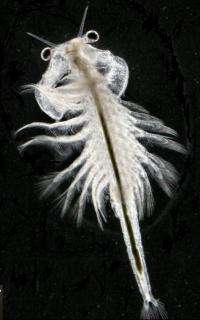June 20, 2011 report
Coevolution not healthy for the female sea monkey

(PhysOrg.com) -- In a new study titled Male-Female Coevolution in the Wild: Evidence from a Time Series in Artemia Franciscana and published in Evolution, evolutionary ecologist Nicolas Rode from the Centre for Functional and Evolutionary Ecology looked at the sexual behavior of the sea monkey and what happened when females were bred with past and future generations.
Sea monkeys, or brine shrimp, lay eggs that are tough in nature and are able to survive for long periods of time. They can lay dormant for years, as in the case of a drought, and then once the water returns are then able to hatch.
Looking at the Great Salt Lake in Utah, researchers collected eggs from layers that had formed in 1985, 1996 and 2007. They took these eggs back to the lab and allowed them to hatch. Keeping each generation separate, the researchers then bred the females with eggs from their generation and previous and past generations.
What they discovered was that the longer the time difference between the male and female partner, the sooner the female sea monkey died. When a female from 1985 was bred with a male from 2007, her life span was cut short by as much as 12 percent.
The research seems to match the idea of sexual conflict and that female shrimp are best suited to breed with their own generation. It appears males and females adapt new mating strategies through different generations and this proves deadly for the female sea monkey.
The change in sexual partners from a different generation did not however seem to have an effect on the female’s reproductive success. Even though they were dying faster, they were also producing eggs at a faster rate.
The one mystery still puzzling the researchers is just how the males are harming the females and shortening their lifespan.
More information: MALE-FEMALE COEVOLUTION IN THE WILD: EVIDENCE FROM A TIME SERIES IN ARTEMIA FRANCISCANA, Evolution, DOI: 10.1111/j.1558-5646.2011.01384.x
ABSTRACT
Sexual conflicts are ubiquitous in nature and are expected to lead to an antagonistic coevolution between the sexes. This coevolutionary process is driven by selection on sexually antagonistic traits that can either be directional or fluctuating. In this study, we used dormant cysts of Artemia franciscana, collected in the same population in three different years over a 23-year period (corresponding to ∼160 generations in this system), to investigate male-female coevolution in natural conditions over time. We performed a cross experiment study where reproduction of females mated to males from the past, present or future was monitored until death. In agreement with a model of ‘fluctuating selection’, we found that females survived better and had longer interbrood intervals when mated with their contemporary males compared to when mated with males from the future or the past. However, female weekly and lifetime reproductive successes displayed no differences between contemporary and non-contemporary matings. Finally, the coevolutionary patterns (‘arms race dynamics’ or ‘fluctuating selection dynamics’) possibly acting on female relative fitness could not be discriminated. This study is the first direct demonstration that the process of male – female coevolution, previously revealed by experimental evolution in laboratory artificial conditions, can occur in nature on a short evolutionary time scale.
© 2010 PhysOrg.com

















